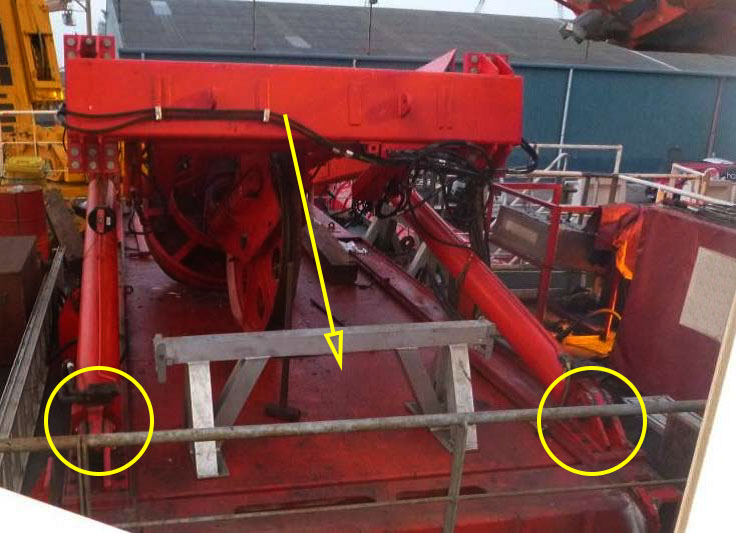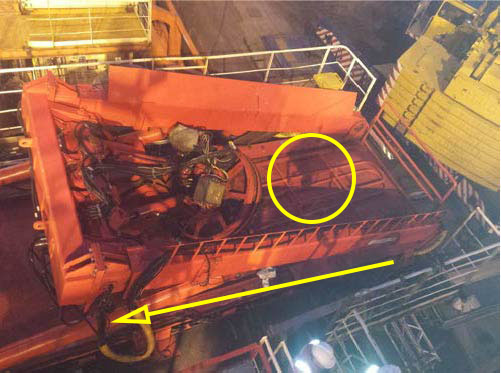Near-miss: Collapse of ROV launch and recovery system (LARS)
A member has reported an incident in which a launch and recovery system (LARS) collapsed causing damage to the sheave, snubber and LARS deck plates. The incident occurred during the demobilisation of an ROV spread. A Lawson type ROV LARS ‘A’ frame was required to be lowered into its stowage position and lifted from the vessel onto the quayside. During this process the ‘A’ frame collapsed.
During the disassembly of the LARS, existing company procedures were not consulted by the ROV team. As a result, an ROV supervisor attempted to lower the ‘A’ frame with his own perceived method, and subsequently the ‘A’ frame fell in an uncontrolled manner to the deck. The method of lowering one supporting hydraulic ram at a time whilst the other is firmly bolted into place was not followed. The supervisor removed all the securing bolts from the feet of both the hydraulic rams, believing the system would gently slide down into the stowage position. To aid the initial movement of the rams, the two supervisors stood on the LARS platform and started striking the feet with a sledge hammer, one ram at a time. Once the first ram moved approx. 13cm, they then struck the second ram which resulted in the ‘A’ frame collapsing at speed. Both supervisors were extremely fortunate that they were not struck by the falling ‘A’ frame -they were unharmed, but this incident had the potential for serious injury/loss of life.


NB: Photographs are of actual worksite after event. Yellow arrow denotes direction in which ‘A’ frame collapsed
Our member’s investigation noted the following:
- An important opportunity to stop the job was missed – an able seaman not involved in the operation asked the ROV team if they would like the assistance of the vessel crane to support the ‘A’ frame during the lowering process. He explained that he had seen this done before during other demobilisations and the process the ROV team were using did not seem safe. His advice was not taken -If in doubt STOP the job;
- No proper control of work – no toolbox talk, risk assessment, method statement or hazard identification and risk assessment (HIRA);
- Procedures were not followed;
- Poor hazard awareness and poor risk perception of the task;
- Insufficient management and control of the work;
- Poor supervision and poor leadership at the work site;
- Incomplete technical understanding of the equipment;
- Personnel were not competent for the task in hand.
Our member reflected that the reoccurrence of dropped object incidents throughout its fleet is evidence that dropped objects are still harming and have the potential to kill. This incident could have been averted if the procedures had been followed and the basic safety management tools used to control the works. Active supervision of the work site and control of works by the vessel management is vitally important to ensure safe operations are conducted at all times.
Members can find many incidents in which the immediate and root causes are inadequate control of work, procedures not followed etc. Likewise there are many dropped object incidents, and a number of dissimilar incidents involving ROVs or LARS. It is possible that this incident, in which basic failure to follow common safety procedures led to a serious dropped object near miss involving very heavy equipment, may be without precedent amongst recorded safety flashes.
Members may wish to refer to the following similar incident – Lost time injury (LTI): Dropped object incident – in which the root causes identified included:
- The potential of falling objects was not recognised or identified as a foreseeable and significant risk
- Work instructions were not followed
- ]There was a lack of situational awareness.
Safety Event
Published: 8 July 2014
Download: IMCA SF 11/14
IMCA Safety Flashes
Submit a Report
IMCA Safety Flashes summarise key safety matters and incidents, allowing lessons to be more easily learnt for the benefit of all. The effectiveness of the IMCA Safety Flash system depends on Members sharing information and so avoiding repeat incidents. Please consider adding safetyreports@imca-int.com to your internal distribution list for safety alerts or manually submitting information on incidents you consider may be relevant. All information is anonymised or sanitised, as appropriate.
IMCA’s store terms and conditions (https://www.imca-int.com/legal-notices/terms/) apply to all downloads from IMCA’s website, including this document.
IMCA makes every effort to ensure the accuracy and reliability of the data contained in the documents it publishes, but IMCA shall not be liable for any guidance and/or recommendation and/or statement herein contained. The information contained in this document does not fulfil or replace any individual’s or Member's legal, regulatory or other duties or obligations in respect of their operations. Individuals and Members remain solely responsible for the safe, lawful and proper conduct of their operations.
